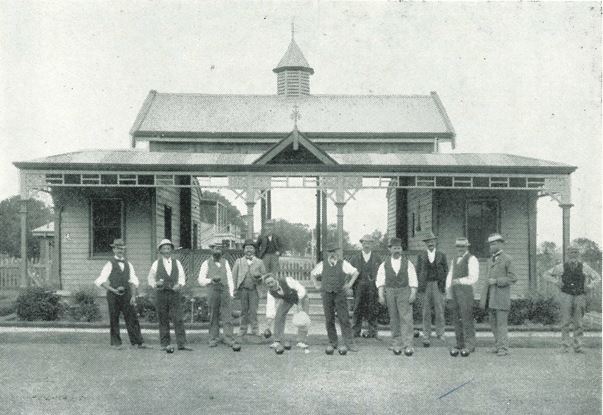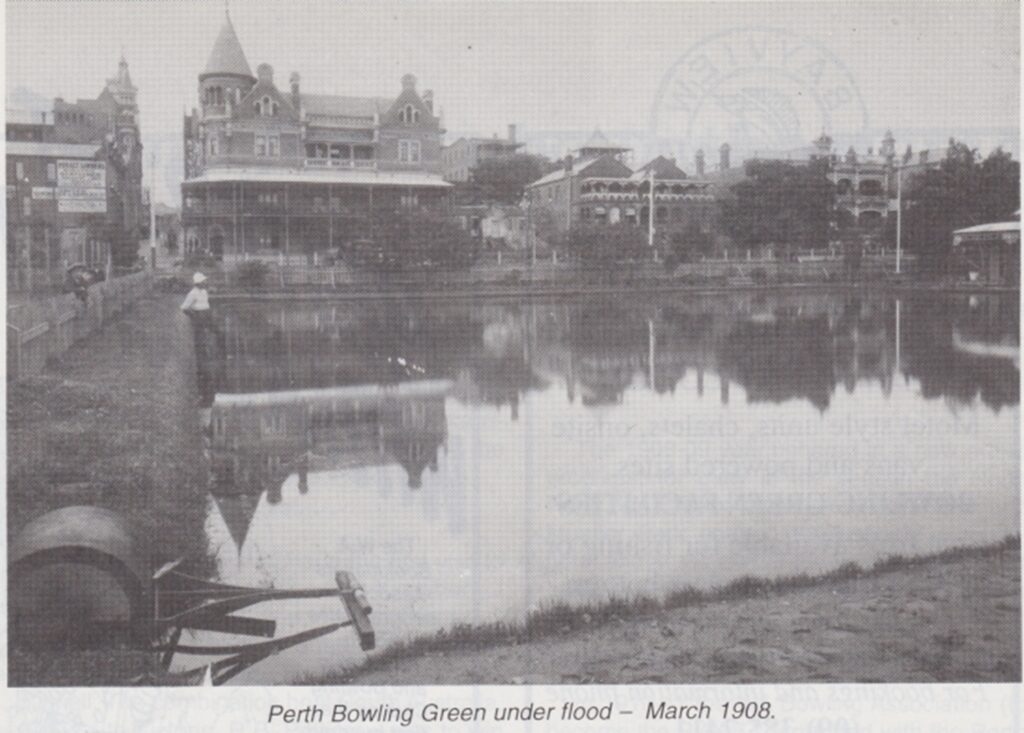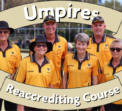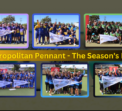10 Bowls Clubs that no longer exist? – Perth Bowling Club (original location)
Welcome to the first in what will be a ten-part series of articles looking at former Bowling Club locations as part of the 125th anniversary of the Royal Western Australian Bowling Association now more commonly known as Bowls WA.
The first of these clubs and the oldest is the site of the Perth Bowling Club which was the first bowling club built in Western Australia, officially opened on April 1st 1896 after initial discussions around a bowling club in the Perth colony had begun in 1892. The club was built on reclaimed land from the Swan River on what was known at the time as Bazaar Street now the Esplanade.

The green was on the corner of Howard Street right in front of the Esplanade Hotel which provided a picturesque backdrop.

The club’s first President was none other than Sir John Forrest, also the State Premier at the time and the club had an impressive 170 members, with Lady Forrest rolling the first official bowl which trailed the jack much to the applause of the large crowd in attendance. Lord Forrest was not a bowler himself as evidenced by his speech on the day when he alluded to “bowling out his opponents” which was more suited to a cricket audience.

Perth then became one of just three foundations clubs of the Association with Fremantle and Swan both of whom still exist at their original sites, although the Fremantle clubhouse was rebuilt less than a hundred metres from its original location. The West Australian Bowling Association formed in 1898 with Thomas B Jackson, the inaugural Vice President and subsequent President of the Perth Bowling Club, becoming the state association’s first President.
The original one room clubhouse underwent expansion in 1910 to allow for offices for the President and Secretary of the State Association, which was continuing to grow both in terms of clubs and playing events.
As the State Association expanded many current and former members of the Perth club were instrumental in helping set up other clubs both in the outer areas of the Perth colony, but also in country areas although the Perth club was still considered the premier venue in the state. In 1914 the club hosted a two-test series between a Metropolitan side and Country side which attracted a crowd of around 800 spectators.
The Perth Bowling Club won seven A-Grade championships as it was known before becoming Premier League at this venue and was home to three State Singles Champions in C Corpaccioli 1902, R Pettigrew 1910 and E Ford 1918 & 1921.


In 1944 the club celebrated its 50th anniversary where a now 89 year old Corpaccioli was awarded life membership with the Perth Lord Mayor Dr Meaghier a guest of honour. The expansion of Perth was beginning to place the club under pressure, however the Mayor declared the club had every possible support from the Perth City Council, “If ever a time came,” Dr Meaghier said, “when a local authority did not take an active and kindly interest In sport, It would Indicate there is something wrong with that local authority.” Referring to a proposal (now in suspense) that the Perth green be transferred to a new location east of Barrack Street.
However, it wasn’t long before more pressure was coming to bear with talk in 1947 around a new bus terminal and a change to the Perth road system; however no action took place.
The Esplanade was also home to other sporting clubs with Australian Rules football, rugby, soccer, tennis, quoits, croquet, polo, lacrosse, baseball, and hockey all played on a regular basis. An article published in 1954 talked about the Council imposing a ban on sport after sunset due to excessive damage to the bowling greens. It seems members of other clubs with sprigs were retrieving errant balls whilst some hockey players were using the clubs’ fence as target practice. The ban did not go down well with the club who laid the complaints. “We merely wanted reasonable protection for our bowling greens for which we pay 1000 pounds a year in maintenance.” said Club President A T Hulin in a newspaper article.
In 1957 the club received a letter from the City Council that it would be required to vacate the premises. This notice meant very little upgrades, or any serious maintenance took place over the following years leaving the building in a poor condition approaching the 1964/65 season. In copies of letters contained in Bowls WA archives the club was engaged in serious discussion with the Metropolitan Regional Planning Authority and the Perth City Council over moving onto a prepared site east of Plain Street which was part of Langley Park.
The continual talk of relocation, a poor building and lack of parking facilities was seeing members leave to other clubs and the club was still in limbo and having to continually seek license extensions whilst the final details were being ironed out.
Along with the other sporting clubs on the Esplanade area all were relocated to make way for a new road system. The Bowling Club was eventually reopened in its current location on Plain Street in 1969 where to this day it still carries forward the historical tradition of the first Bowling Club in Perth.
The Club later merged with the Tattersalls Club in 1978 to form the Perth & Tattersalls Bowling and Recreation Club, as it is known today. The affiliation with Tattersalls is now diminished with the advent of online bookmaking however the Club is continuing to thrive at this location and provides bowling and community facilities to residents and businesses throughout the CBD.
The old Bowling Club site was converted to a Memorial Garden with the Esplanade Road being widened and 9-12 inches of soil added to the Esplanade Reserve to prevent flooding which had plagued the bowls green in the winter over many years.

Today the original club site is just concrete and a small amount of lawn with no formal recognition of what was there beforehand, where the great bowlers and administrations laid the foundations of the sport of bowls in Western Australia.




